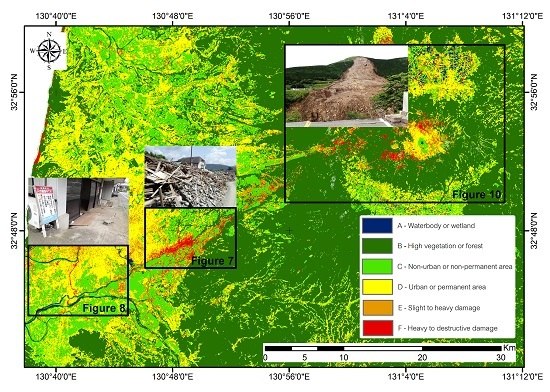Fusion of Multi-Temporal Interferometric Coherence and Optical Image Data for the 2016 Kumamoto Earthquake Damage Assessment
Abstract
:1. Introduction
2. Materials and Methods
2.1. Study Area and Data Collection
2.2. Interferometric SAR Coherence
2.3. Interferometric SAR Coherence Change for the Earthquake Damage Assessment
2.4. Landsat-8 InformatioN: NDVI and NDWI
2.5. Image Classification for the Earthquake Damage Assessment
2.6. Accuracy Assessment
- Landslide areas from the combination of ALOS-2 and Landsat-8 data: these results were checked with large landslide information from the Geospatial Information Authority of Japan (GSI) [36].
3. Results
- A—Waterbodies or wetlands;
- B—Forested areas or highly vegetated areas;
- C—Non-building or non-permanent areas;
- D—Urban areas with no to slight damage;
- E and F—Affected areas including those with building damage, liquefaction regions in urban areas, and landslides induced by the earthquake.
- Building damage caused by ground motion, i.e., buildings destroyed directly by surface movement. The degree of damage was classified into three damage patterns (see Section 3.1);
- Damage caused by liquefaction. This damage was related to the ground subsidence and inclination of buildings, which lead to losses of coherence in the SAR images between the earthquake periods assessed. The liquefaction areas showed high coherence in the E and F classes (see Section 3.2);
- Landslides induced by the earthquake. Interferometric SAR coherence combined with optical imagery or Landsat-8 data in this study were used to assess the landslides in a more precise manner than what could be achieved with SAR data alone. The areas surrounded by forests or highly vegetated areas were considered as potential landslide sites (see Section 3.3).
3.1. Buildings Damaged by Ground Motion
- D—No damage to slight damage: slight structural damage included walls with cracks, roofing tile displacements, and wall mortar that was somewhat peeled off;
- E—Slight to heavy damage: this included considerable nonstructural and slight structural damage to considerable structural and extensive nonstructural damage, such as damage to portions of columns, beams, or walls and collapsed roof tiles;
- F—Heavy to destructive damage: this included structures that were more economical to demolish than repair, such as inclined, nearly collapsed, and completely collapsed buildings.
3.2. Buildings Damaged by Liquefaction
3.3. Landslide Areas
4. Discussion
4.1. Overall Study
4.2. Building Damage by Ground Motion and Liquefaction
4.3. Landslides
4.4. Recommendations
5. Conclusions
Acknowledgments
Author Contributions
Conflicts of Interest
References
- Ansal, A. Perspectives on European Earthquake Engineering and Seismology; Springer: Cham, Switzerland, 2014; Volume 1, pp. 53–95. [Google Scholar]
- Boccardo, P.; Tonolo, F.G. Remote sensing role in emergency mapping for disaster response. In Engineering Geology for Society and Territory—Volume 5: Urban Geology, Sustainable Planning and Landscape Exploitation; Springer: Cham, Switzerland, 2015; pp. 17–24. [Google Scholar]
- Eguchi, R.T.; Huyck, K.; Adams, B.J.; Mansouri, B.; Houshmand, B.; Shinozuka, M. Resilient Disaster Response: Using Remote Sensing Technologies for Post-Earthquake Damage Detection. MCEER Research and Accomplishements 2001–2003; Multidiscplinary Center for Earthquake Engineering Research (MCEER): Buffalo, NY, USA, 2003; pp. 125–137. [Google Scholar]
- Miyazaki, H.; Nagai, M.; Shibasaki, R. Reviews of geospatial information technology and collaborative data delivery for disaster risk management. ISPRS Int. J. Geo-Inf. 2015, 4, 1936–1964. [Google Scholar] [CrossRef]
- Dong, L.; Shan, J. A comprehensive review of earthquake-induced building damage detection with remote sensing techniques. ISPRS J. Photogramm. Remote Sens. 2013, 84, 85–99. [Google Scholar] [CrossRef]
- Cooner, A.J.; Shao, Y.; Campbell, J.B. Detection of urban damage using remote sensing and machine learning algorithms: Revisiting the 2010 Haiti earthquake. Remote Sens. 2016, 8, 868. [Google Scholar] [CrossRef]
- Barazzetti, L.; Brumana, R.; Cuca, B.; Previtali, M. Change detection from very high resolution satellite time series with variable off-nadir angle. In Proceedings of the Third International Conference on Remote Sensing and Geoinformation of the Environment, Paphos, Cyprus, 16 March 2015; Volume 3. [Google Scholar]
- Yamazaki, F. Earthquake damage detection using high-resolution satellite images. In Proceedings of the 2004 IEEE Interational Geoscience and Remote Sensing Symposium, Anchprage, AK, USA, 20–24 September 2004. [Google Scholar]
- Plank, S. Rapid damage assessment by means of multi-temporal SAR—A comprehensive review and outlook to Sentinel-1. Remote Sens. 2014, 6, 4870–4906. [Google Scholar] [CrossRef]
- Matsuoka, M.; Yamazaki, F. Use of interferometric satellite SAR for earthquake damage detection. In Proceedings of the 6th International Conference on Seismic Zonation, EERI, Palm Springs, CA, USA, 12–15 November 2000. [Google Scholar]
- Arciniegas, G.A.; Bijker, W.; Kerle, N.; Tolpekin, V.A. Coherence- and amplitude-based analysis of seismogenic damage in Bam, Iran, using ENVISAT ASAR data. IEEE Trans. Geosci. Remote Sens. 2007, 45, 1571–1581. [Google Scholar] [CrossRef]
- Hoffmann, J. Mapping damage during the Bam (Iran) earthquake using interferometric coherence. Int. J. Remote Sens. 2007, 28, 1199–1216. [Google Scholar] [CrossRef]
- Watanabe, M.; Thapa, R.B.; Ohsumi, T.; Fujiwara, H.; Yonezawa, C.; Tomii, N.; Suzuki, S. Detection of damaged urban areas using interferometric SAR coherence change with PALSAR-2. Earth Planets Space 2016, 68, 131. [Google Scholar] [CrossRef]
- Ge, L.; Ng, A.H.-M.; Li, X.; Liu, Y.; Du, Z.; Liu, Q. Near real-time satellite mapping of the 2015 Gorkha earthquake, Nepal. Ann. GIS 2015, 21, 175–190. [Google Scholar] [CrossRef]
- Yun, S.-H.; Hudnut, K.; Owen, S.; Webb, F.; Simons, M.; Sacco, P.; Gurrola, E.; Manipon, G.; Liang, C.; Fielding, E.; et al. Rapid damage mapping for the 2015 Mw 7.8 Gorkha earthquake using synthetic aperture radar data from COSMO—SkyMed and ALOS-2 Satellites. Seismol. Res. Lett. 2015, 86, 1549–1556. [Google Scholar] [CrossRef]
- Stramondo, S.; Bignami, C.; Chini, M.; Pierdicca, N.; Tertulliani, A. Satellite radar and optical remote sensing for earthquake damage detection: Results from different case studies. Int. J. Remote Sens. 2006, 27, 4433–4447. [Google Scholar] [CrossRef]
- United States Geological Survey (USGS). M7.0-1 km E of Kumamoto-shi, Japan. Available online: https://earthquake.usgs.gov/earthquakes/eventpage/us20005iis#executive (accessed on 30 May 2016).
- Yagi, Y.; Okuwaki, R.; Enescu, B.; Kasahara, A.; Miyakawa, A.; Otsubo, M. Rupture process of the 2016 Kumamoto earthquake in relation to the thermal structure around Aso volcano. Earth Planets Space 2016, 68, 118. [Google Scholar] [CrossRef]
- Cross, J.R. Red Cross Responses Keep the Kumamoto Red Cross Hospital Operating. Available online: http://reliefweb.int/report/japan/japan-kumamoto-earthquake-one-month-report-infographics-17-may-2016 (accessed on 30 June 2016).
- Hanssen, R.F. Remote Sensing and Digital Image Processing. In Radar Interferometry: Data Interpretation and Error Analysis; Springer: Dordrecht, The Netherlands, 2001; Volume 2, p. 38. [Google Scholar]
- Stramondo, S.; Moro, M.; Tolomei, C.; Cinti, F.R.; Doumaz, F. InSAR surface displacement field and fault modelling for the 2003 Bam earthquake (southeastern Iran). J. Geodyn. 2005, 40, 347–353. [Google Scholar] [CrossRef]
- Raucoules, D.; Ristori, B.; de Michele, M.; Briole, P. Surface displacement of the Mw 7 Machaze earthquake (Mozambique): Complementary use of multiband InSAR and radar amplitude image correlation with elastic modelling. Remote Sens. Environ. 2010, 114, 2211–2218. [Google Scholar] [CrossRef]
- Sandwell, D.; Mellors, R.; Tong, X.; Wei, M.; Wessel, P. GMTSAR: An InSAR Processing System Based on Generic Mapping Tools. Available online: http://escholarship.org/uc/item/8zq2c02m (accessed on 15 May 2014).
- Yonezawa, C.; Takeuchi, S. Dection of urban damage using interferometric SAR decorrelation. In Proceedings of the 1999 IEEE International Geoscience and Remote Sensing Symposium, Hamburg, Germany, 28 June–2 July 1999. [Google Scholar]
- Lindsey, E.O.; Natsuaki, R.; Xu, X.; Shimada, M.; Hashimoto, M.; Melgar, D.; Sandwell, D.T. Line-of-sight displacement from ALOS-2 interferometry: Mw 7.8 Gorkha Earthquake and Mw 7.3 aftershock. Geophys. Res. Lett. 2015, 42, 6655–6661. [Google Scholar] [CrossRef]
- Sandwell, D.T.; Myer, D.; Mellors, R.; Shimada, M.; Brooks, B.; Foster, J. Accuracy and resolution of ALOS interferometry: Vector deformation maps of the Father’s Day intrusion at Kilauea. IEEE Trans. Geosci. Remote Sens. 2008, 46, 3524–3534. [Google Scholar] [CrossRef]
- Ishitsuka, K.; Tsuji, T.; Matsuoka, T. Detection and mapping of soil liquefaction in the 2011 Tohoku earthquake using SAR interferometry. Earth Planets Space 2013, 64, 1267–1276. [Google Scholar] [CrossRef]
- Xu, H. Modification of normalised difference water index (NDWI) to enhance open water features in remotely sensed imagery. Int. J. Remote Sens. 2006, 27, 3025–3033. [Google Scholar] [CrossRef]
- Google Earth. Available online: https://www.google.com/earth/ (accessed on 5 December 2016).
- Google Maps. Available online: https://www.google.co.th/maps/ (accessed on 5 December 2016).
- Google Street View. Available online: https://www.google.com/streetview/ (accessed on 5 December 2016).
- Liquefaction Survey for Kumamoto Earthquake by JSCE. Available online: http://committees.jsce.or.jp/eec205/system/files/liq_survey_2016kumamoto.pdf (accessed on 24 January 2017).
- Preliminary Report: Kumamoto Liquefaction Damage (27 April 2016) by JGS. Available online: https://www.jiban.or.jp/images/saigai/H28Kumamoto_jisinsaigai_0427ekijoka.pdf (accessed on 24 January 2017).
- Preliminary Report: Kumamoto Liquefaction Damage (24 June 2016) by Fukuoka University. Available online: http://www.tec.fukuoka-u.ac.jp/tc/labo/drr/gis/H28KumamotoEQ/kaisetsu0624.pdf (accessed on 24 January 2017).
- Preliminary Report: Kumamoto Liquefaction Damage (11 May 2016) by JGS. Available online: https://www.jiban.or.jp/images/saigai/H28Kumamoto_jisinsaigai_0511ekijoka.pdf (accessed on 24 January 2017).
- Information about the 2016 Kumamoto Earthquake, GSI. Available online: http://www.gsi.go.jp/BOUSAI/H27-kumamoto-earthquake-index.html (accessed on 5 January 2016).
- Earthquake Engineering Research Institute (EERI). Section 7 Engineered Buildings—Field Investigation. Available online: https://www.eeri.org/lfe/pdf/Field_Guide_Section_7.pdf (accessed on 8 January 2016).
- Okada, S.; Takai, N. Classifications of structural types and damage patterns of buildings for earthquake field investigation. In Proceedings of the 12th World Conference on Earthquake Engineering, Auckland, New Zealand, 30 January–4 February 2000; pp. 1–8. [Google Scholar]
- Hengjian, L.; Kohiyama, M.; Horie, K.; Maki, N.; Hayashi, H.; Tanaka, S. Building damage and casualties after an earthquake. Nat. Hazards 2003, 29, 387–403. [Google Scholar] [CrossRef]
- Aghda, S.M.F.; Koike, K.; Suzuki, A.; Kitazono, Y. Geological hazard risk assessment by using fuzzy sets theory. Geoinformatics 1994, 5, 113–128. [Google Scholar] [CrossRef]
- Chen, F.; Guo, H.; Ishwaran, N.; Zhou, W.; Yang, R.; Jing, L.; Chen, F.; Zeng, H. Synthetic aperture radar (SAR) interferometry for assessing Wenchuan earthquake (2008) deforestation in the Sichuan giant panda site. Remote Sens. 2014, 6, 6283–6299. [Google Scholar] [CrossRef]
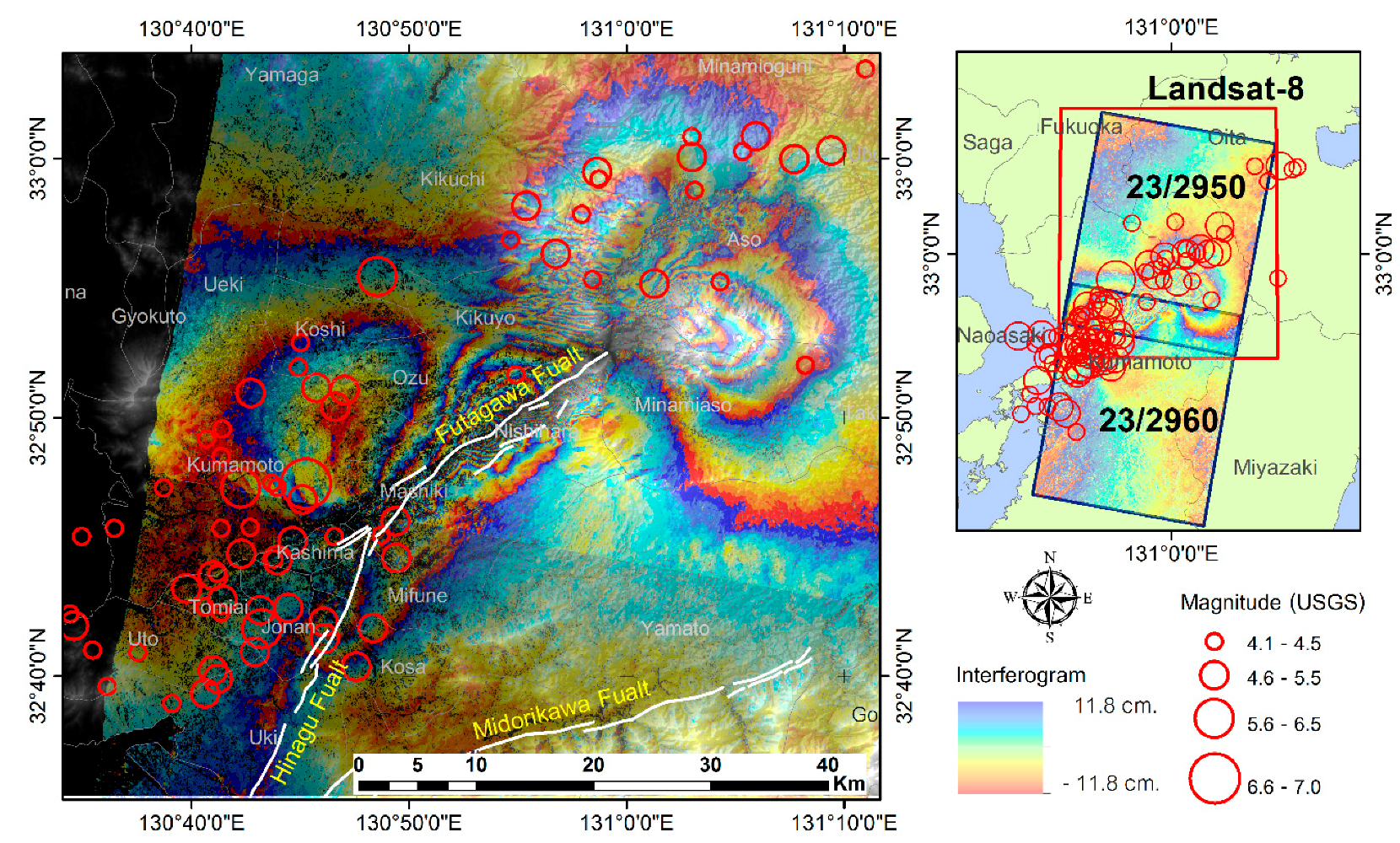

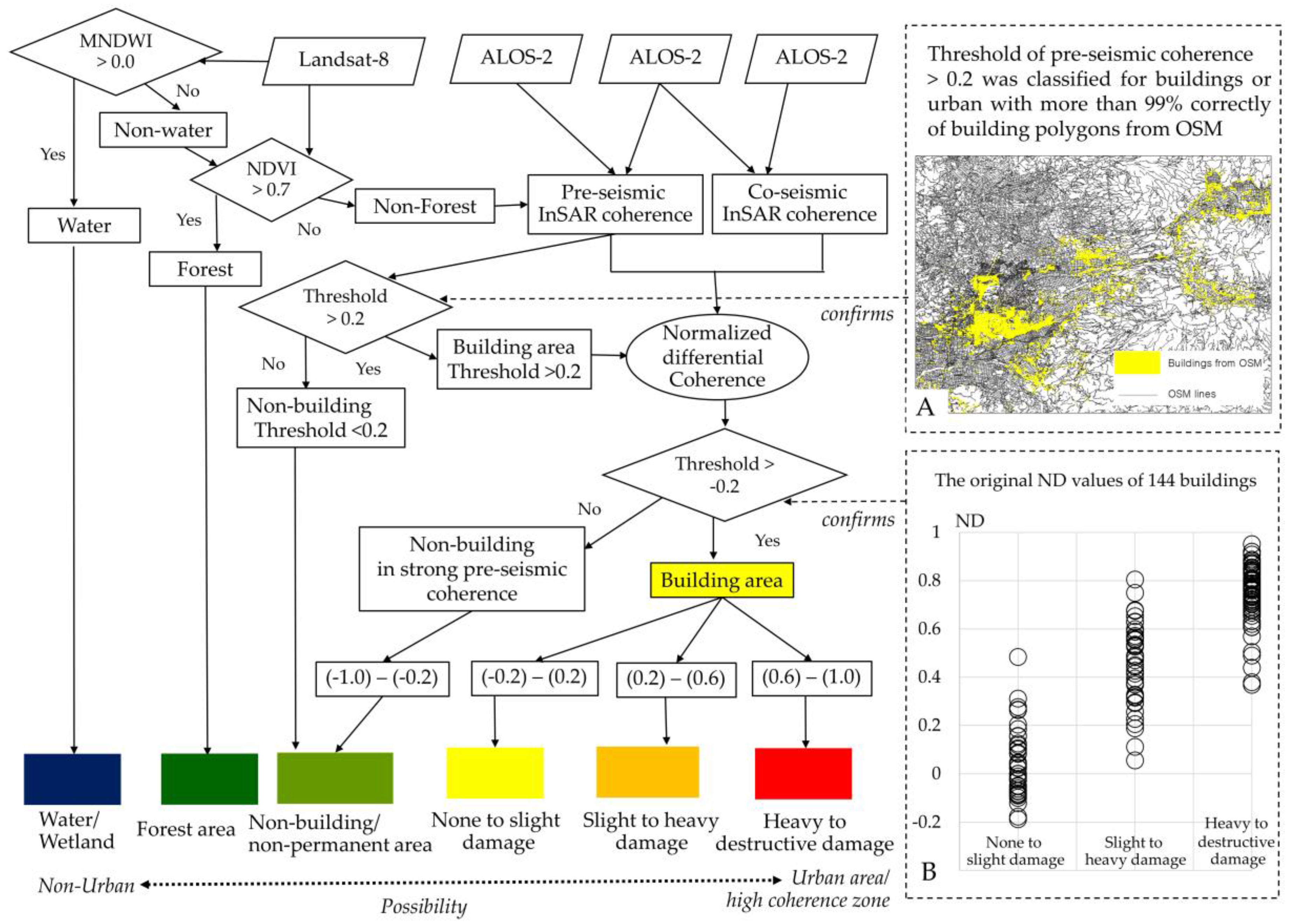
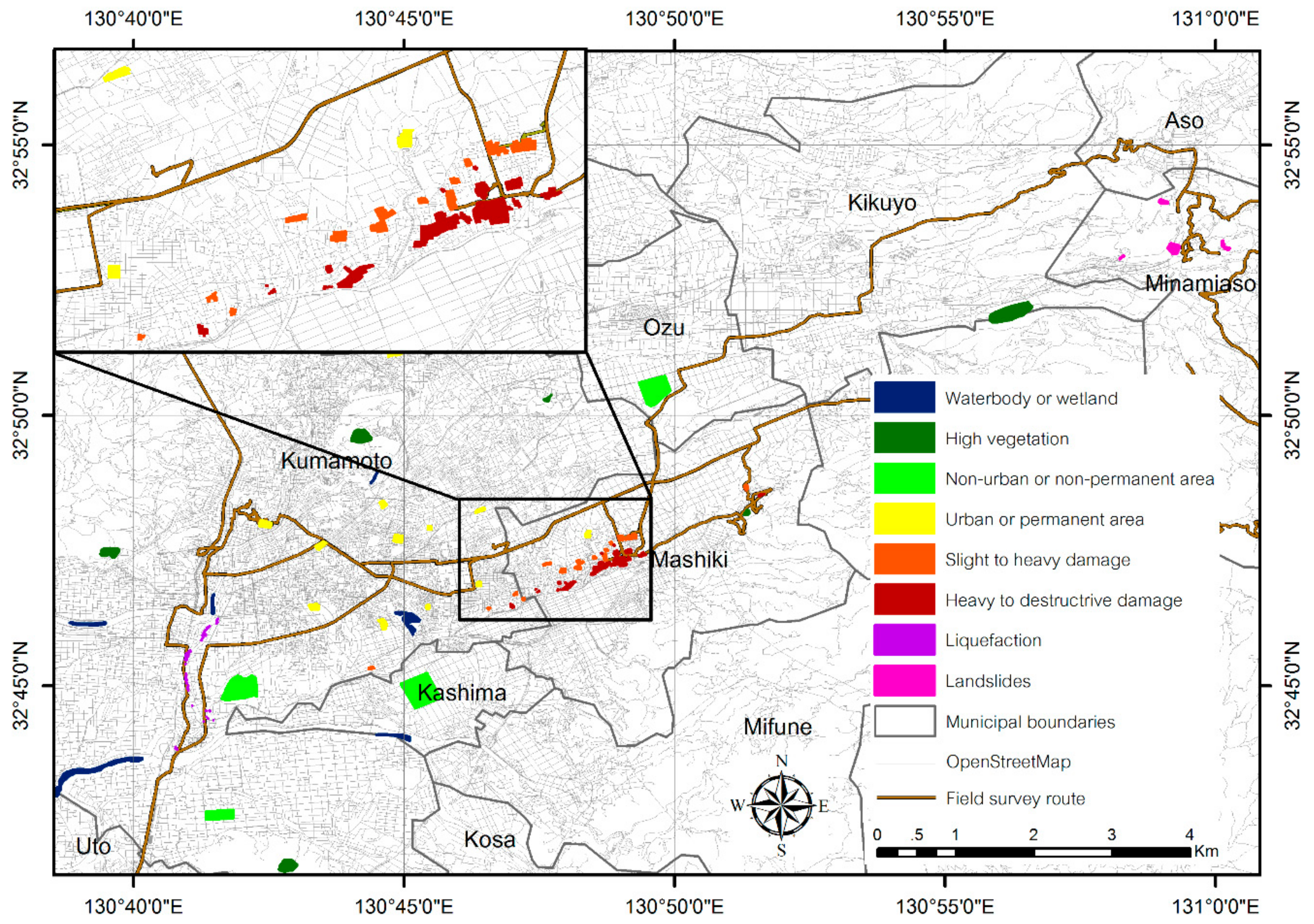
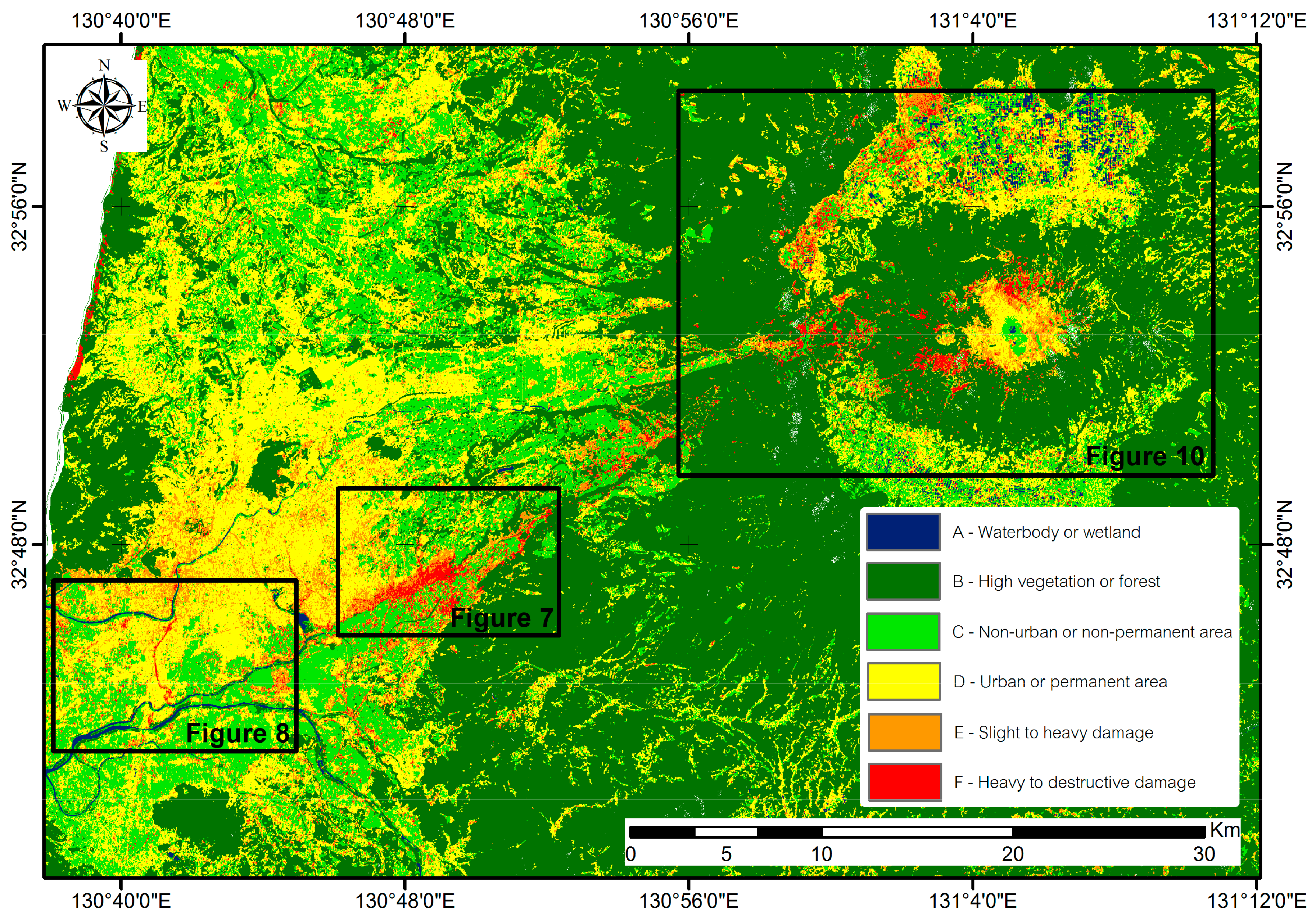
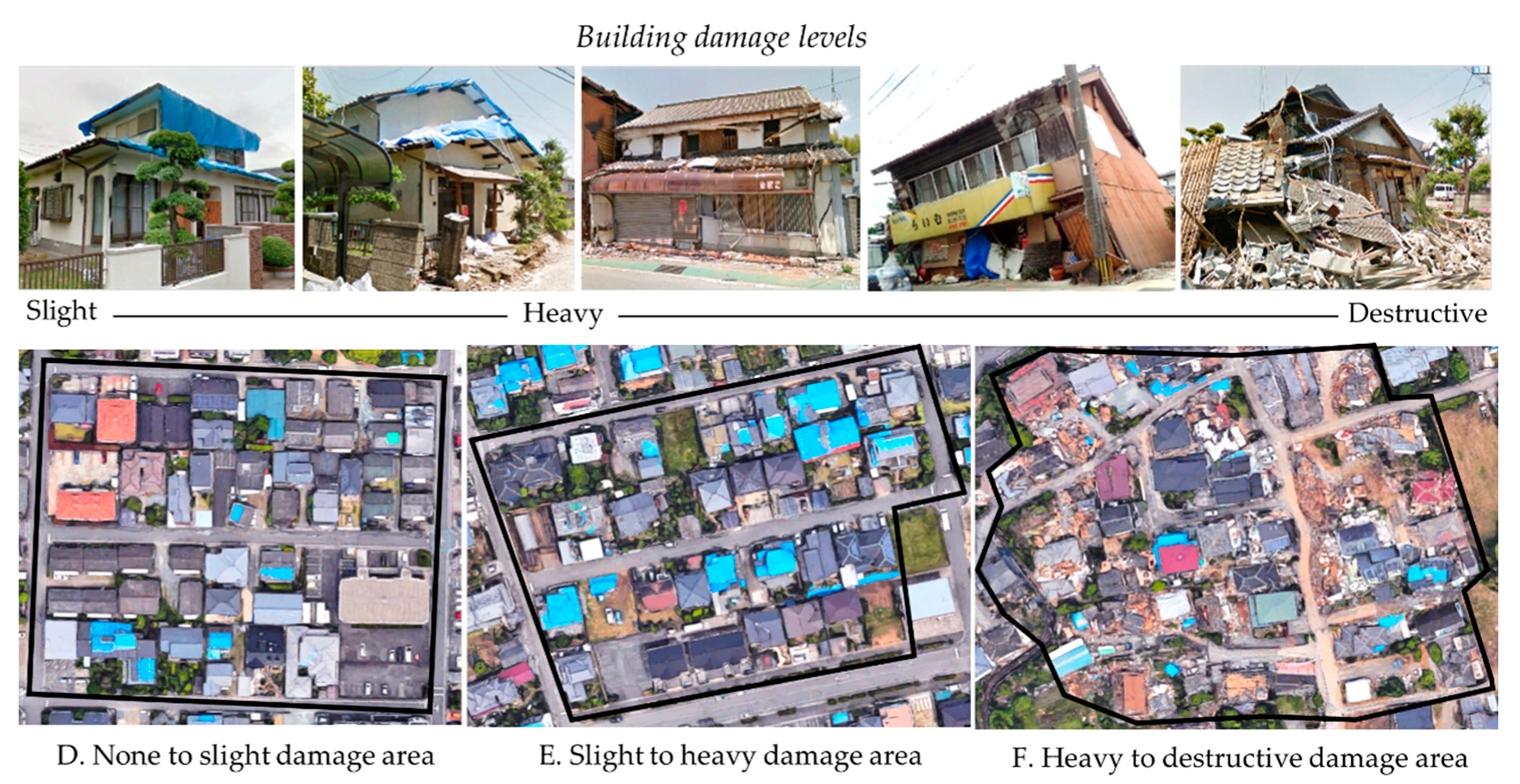
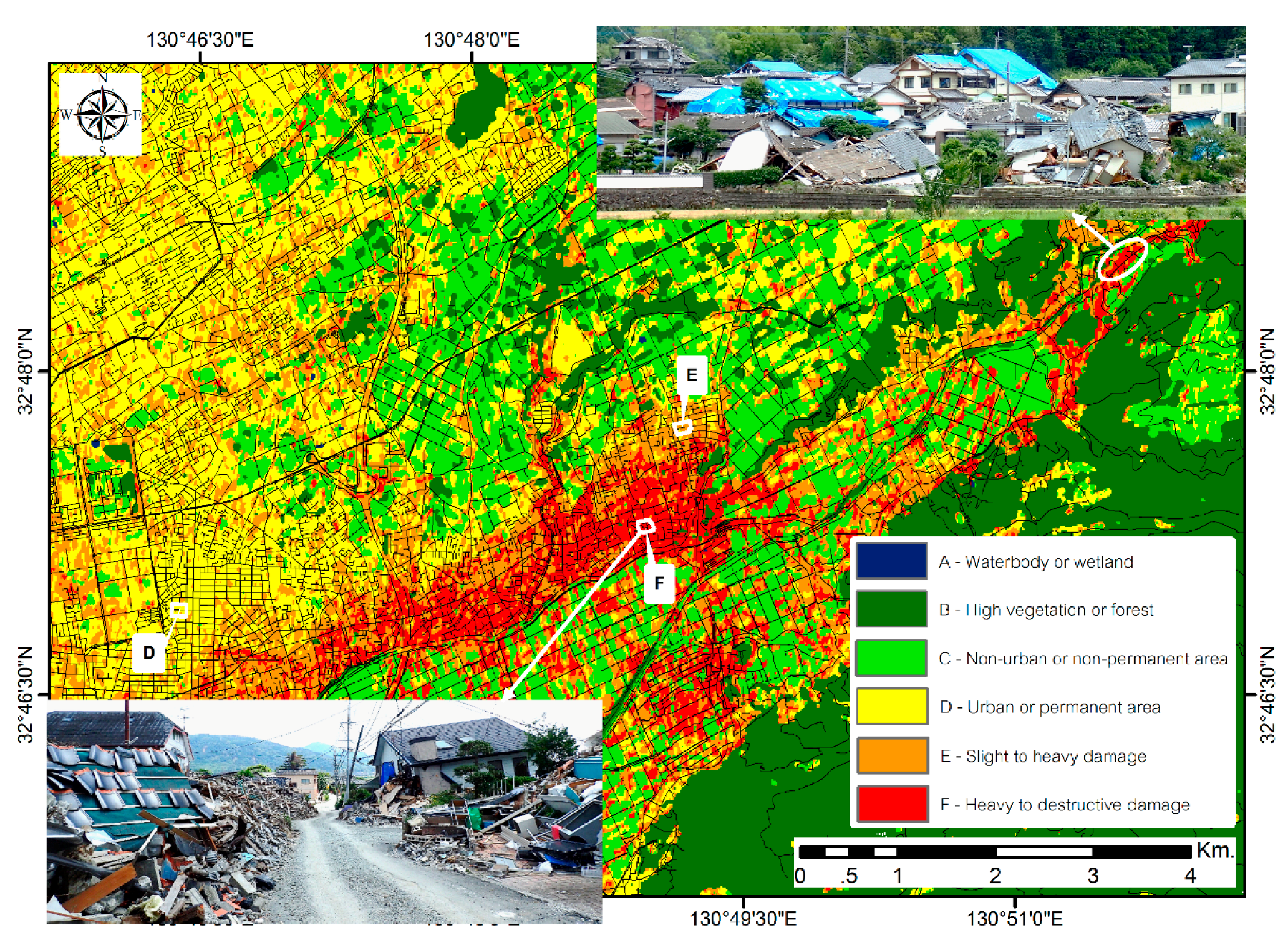
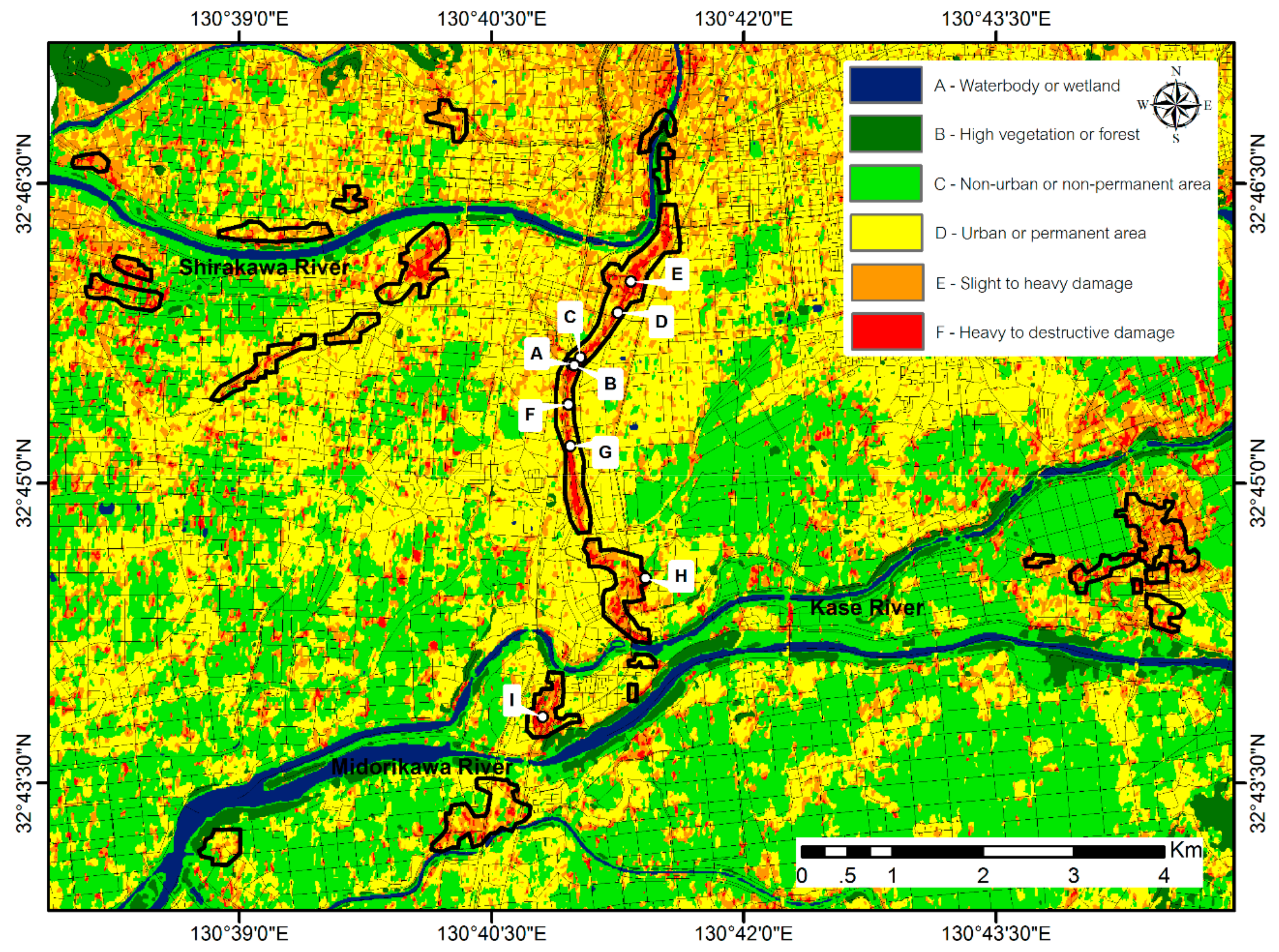
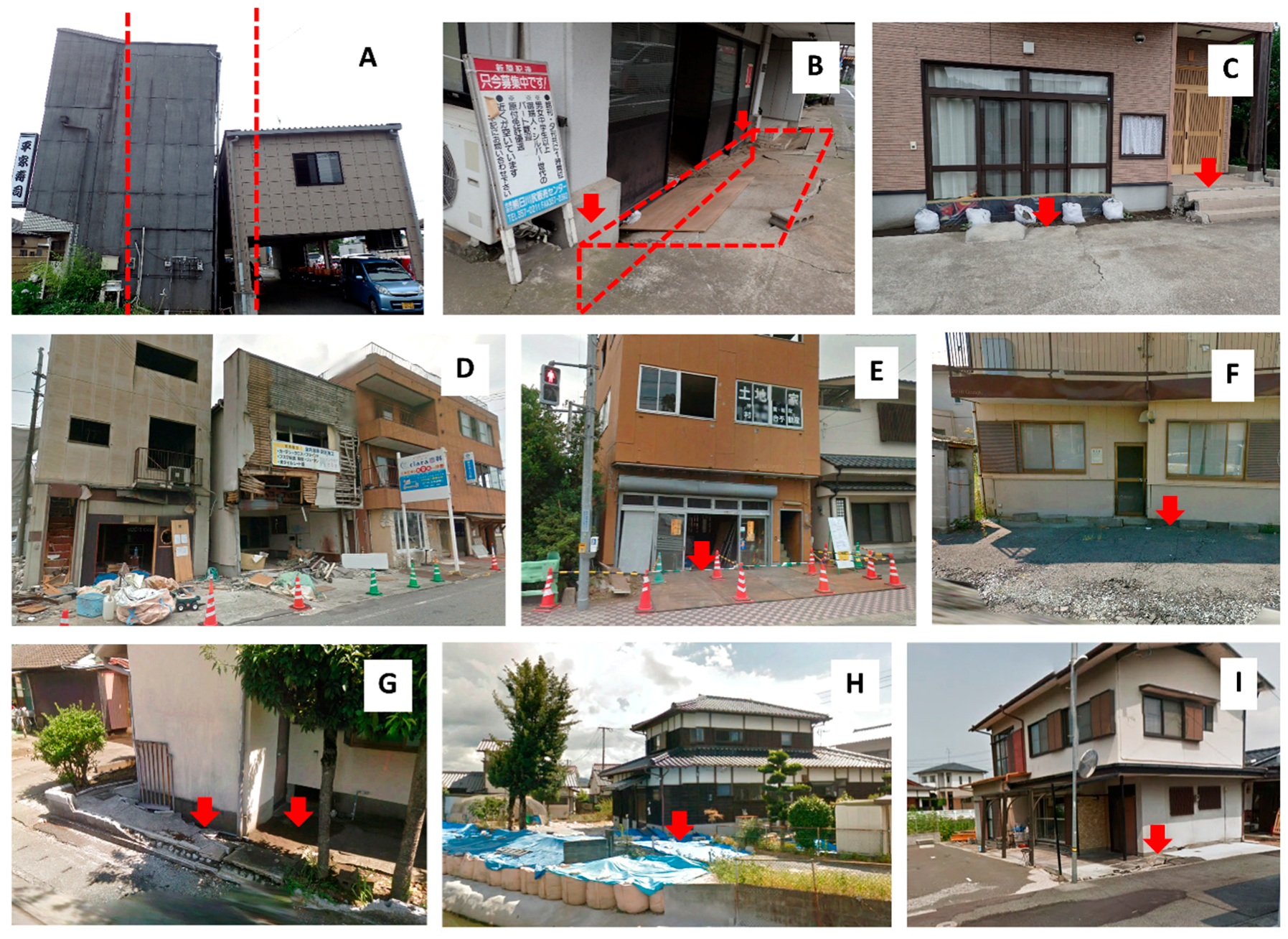

| Satellite Images | Acquisition Date |
|---|---|
| ALOS-2 before event | 2015/11/30 |
| ALOS-2 before event | 2016/03/07 |
| ALOS-2 after event | 2016/04/18 |
| Landsat-8 | 2016/05/23 |
| DInSAR | Master (Date) | Slave (Date) | Perpendicular Baseline (m) | Parallel Baseline (m) | Time (Days) |
|---|---|---|---|---|---|
| Pre-EQ 23/2950 | 2015/11/30 | 2016/03/07 | 33.698301 | −102.815781 | 98 |
| Pre-EQ 23/2960 | 2015/11/30 | 2016/03/07 | 31.493618 | −104.774610 | 98 |
| During EQ 23/2950 | 2016/03/07 | 2016/04/18 | −88.228228 | −115.876068 | 42 |
| During EQ 23/2960 | 2016/03/07 | 2016/04/18 | −89.499914 | −116.796991 | 42 |
| Classes | A | B | C | D | E and F | Total | UA |
|---|---|---|---|---|---|---|---|
| A | 6427 | 38 | 257 | 4 | 1 | 6727 | 95.54% |
| B | 0 | 13,545 | 0 | 33 | 0 | 13,578 | 99.76% |
| C | 9 | 999 | 19,738 | 541 | 263 | 21,550 | 91.59% |
| D | 2 | 0 | 7 | 4488 | 235 | 4732 | 94.84% |
| E and F | 7 (0&7) | 51 (11&40) | 153 (3&150) | 262 (257&5) | 6681 (4921&1760) | 7154 | 93.39% |
| Total | 6445 | 14,633 | 20,155 | 5328 | 7180 | All | 53,741 |
| PA | 99.72% | 92.56% | 97.93% | 84.23% | 93.05% | Correct | 50,879 |
| Classes | D | E | F | Total | UA |
|---|---|---|---|---|---|
| D | 4488 | 191 | 44 | 4723 | 95.02% |
| E | 257 | 1606 | 229 | 2092 | 76.77% |
| F | 0 | 186 | 2900 | 3086 | 93.97% |
| Total | 4745 | 1983 | 3173 | All | 9901 |
| PA | 94.58% | 80.99% | 91.40% | Correct | 8994 |
© 2017 by the authors. Licensee MDPI, Basel, Switzerland. This article is an open access article distributed under the terms and conditions of the Creative Commons Attribution (CC BY) license (http://creativecommons.org/licenses/by/4.0/).
Share and Cite
Tamkuan, N.; Nagai, M. Fusion of Multi-Temporal Interferometric Coherence and Optical Image Data for the 2016 Kumamoto Earthquake Damage Assessment. ISPRS Int. J. Geo-Inf. 2017, 6, 188. https://doi.org/10.3390/ijgi6070188
Tamkuan N, Nagai M. Fusion of Multi-Temporal Interferometric Coherence and Optical Image Data for the 2016 Kumamoto Earthquake Damage Assessment. ISPRS International Journal of Geo-Information. 2017; 6(7):188. https://doi.org/10.3390/ijgi6070188
Chicago/Turabian StyleTamkuan, Nopphawan, and Masahiko Nagai. 2017. "Fusion of Multi-Temporal Interferometric Coherence and Optical Image Data for the 2016 Kumamoto Earthquake Damage Assessment" ISPRS International Journal of Geo-Information 6, no. 7: 188. https://doi.org/10.3390/ijgi6070188
APA StyleTamkuan, N., & Nagai, M. (2017). Fusion of Multi-Temporal Interferometric Coherence and Optical Image Data for the 2016 Kumamoto Earthquake Damage Assessment. ISPRS International Journal of Geo-Information, 6(7), 188. https://doi.org/10.3390/ijgi6070188





